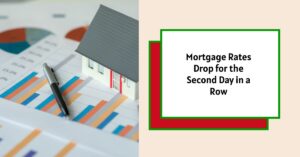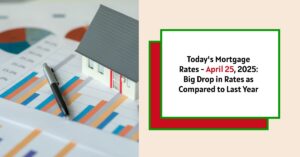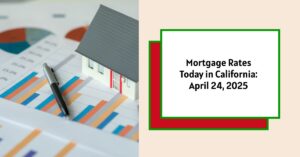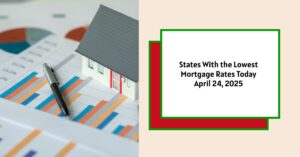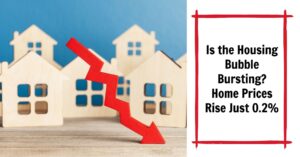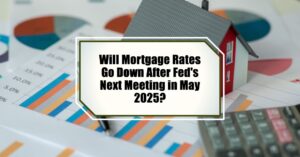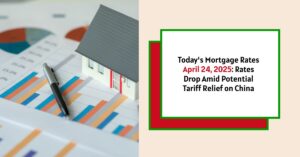If you've been watching mortgage rates with bated breath, there's a bit of good news: Mortgage rates have dropped for a second consecutive day. As of today, Thursday, April 25, 2025, the average rate for a 30-year fixed mortgage is 6.99%. This small dip could signal a shift in the market and influence your home-buying or refinancing decisions. Let's dive into what's happening, why it matters, and what you should consider.
Mortgage Rates Drop for the Second Day in a Row
It feels like mortgage rates have been on a wild ride lately, doesn't it? We've seen them fall, surge, fall again, and then rise. Trying to time the market can feel impossible, and honestly, it often is. One thing I've learned from years of watching the market is that focusing solely on the daily fluctuations can drive you crazy. It's more important to understand the broader trends and how they align with your financial goals.
A Closer Look at Today's Rate Averages
Here’s a quick snapshot of what’s happening with different types of mortgages:
- 30-Year Fixed: 6.99%
- FHA 30-Year Fixed: 7.37%
- 15-Year Fixed: 6.09%
- Jumbo 30-Year Fixed: 7.04%
- 5/6 ARM: 7.45%
As you can see, most loan types saw a decrease today, which is a positive sign if you're in the market for a mortgage.
Context is Key: Putting Today's Rates in Perspective
While today's dip is welcome, it's crucial to remember where we've been. Just a couple of weeks ago, on April 11, the 30-year fixed rate peaked at 7.14%, the highest it had been since May 2024. If you recall, back in September, we saw a two-year low of 5.89%. So, even with the recent drops, we're still significantly higher than those lows.
However, it's also important to note that current rates are about a percentage point lower than in late 2023, when they hit a 23-year peak of 8.01%. This rollercoaster reminds us that mortgage rates are constantly in flux.
How Different Loan Types Are Faring
Let's zoom in on a few specific loan types:
- 15-Year Mortgages: These also experienced a slight decrease, averaging 6.09% today. While still higher than the 4.97% low we saw last September, they're better than the recent high of 6.31% from April 11.
- Jumbo Loans: Rates for these larger loans also dropped, averaging 7.04%. This is an improvement from the 7.15% we saw a couple of weeks ago.
Daily Mortgage Rate Changes (April 25, 2025)
| Loan Type | New Purchase Rates | Daily Change |
|---|---|---|
| 30-Year Fixed | 6.99% | -0.04 |
| FHA 30-Year Fixed | 7.37% | No Change |
| VA 30-Year Fixed | 6.64% | -0.04 |
| 20-Year Fixed | 6.81% | -0.08 |
| 15-Year Fixed | 6.09% | -0.04 |
| FHA 15-Year Fixed | 6.82% | No Change |
| 10-Year Fixed | 6.05% | +0.04 |
| 7/6 ARM | 7.44% | No Change |
| 5/6 ARM | 7.45% | -0.01 |
| Jumbo 30-Year Fixed | 7.04% | -0.05 |
| Jumbo 15-Year Fixed | 6.99% | +0.04 |
| Jumbo 7/6 ARM | 7.04% | -0.24 |
| Jumbo 5/6 ARM | 7.43% | +0.07 |
Source: Zillow
Freddie Mac's Perspective
Freddie Mac, a major player in the mortgage market, also releases its own weekly average of 30-year mortgage rates. This week, they reported 6.81%, a slight dip from the previous week. While their numbers are a bit different from the ones mentioned above, they paint a similar picture: rates are fluctuating.
Why the Discrepancy?
You might be wondering why Freddie Mac's numbers are different. Well, they calculate a weekly average, blending the rates from the past five days. The rates I mentioned above are a daily reading, giving a more immediate snapshot. Also, they have different criteria for the loans they include in their calculations.
Read More:
When Will the Soaring Mortgage Rates Finally Go Down in 2025?
Why Are Mortgage Rates Rising Back to 7%: The Key Drivers
Don't Be Fooled by “Teaser Rates”
One thing I always tell people is to be careful about those super-low rates you see advertised online. These “teaser rates” often come with strings attached. They might require you to pay points upfront or have an almost perfect credit score. Your actual rate will depend on factors like your credit score, income, and the size of your down payment.
What Factors Influence Mortgage Rates?
Mortgage rates aren't determined by a magic formula. Instead, they are influenced by a complex mix of things:
- The Bond Market: What's happening with the bond market, especially 10-year Treasury yields, plays a big role.
- The Federal Reserve: The Fed's policies, particularly around bond buying, have a major influence.
- Competition Among Lenders: Lenders are competing for your business, and that competition can impact rates.
It's really hard to pinpoint one single reason for why rates change. These factors often move together, making it tricky to predict what will happen next.
The Fed's Role in the Past
In the past, the Federal Reserve played a significant role in keeping mortgage rates low. During the pandemic, they bought billions of dollars in bonds, which helped to keep rates down. But they stopped buying bonds in March 2022 and started raising interest rates to combat inflation. While the Fed Funds Rate doesn't directly control mortgage rates, there is some indirect influence.
Looking Ahead: What to Expect from the Fed
The Fed has been holding steady with interest rates for a while now. The central bank may not make another rate cut for months. In March, the Fed released their quarterly rate forecast, which showed that the central bankers’ median expectation for the rest of the year was just two quarter-point rate cuts.
My Thoughts and Recommendations
If you're thinking about buying a home or refinancing, here's what I'd suggest:
- Don't Panic: Mortgage rates are always changing. Try not to make decisions based on daily fluctuations.
- Shop Around: Get quotes from multiple lenders. Rates can vary widely.
- Consider Your Goals: Think about what you can afford and what your long-term financial goals are.
- Talk to a Professional: A good mortgage broker or financial advisor can help you navigate the complexities of the market.
Ultimately, the best time to buy a home is when you're financially ready. Don't let fluctuating interest rates completely derail your plans.
In summary, the recent dip in mortgage rates offers a glimmer of hope for buyers and homeowners alike. However, it's essential to keep these fluctuations in perspective and focus on your own financial readiness. Shopping around, consulting with experts, and understanding the broader market trends will help you make the best decision for your unique situation.
Turnkey Real Estate Investment With Norada
Investing in real estate can help you secure consistent returns with fluctuating mortgage rates.
Despite softer demand, smart investors are locking in properties now while competition is lower and rental returns remain strong.
HOT NEW LISTINGS JUST ADDED!
Speak with an investment counselor (No Obligation):
(800) 611-3060
Also Read:
- Will Mortgage Rates Go Down in 2025: Morgan Stanley's Forecast
- Expect High Mortgage Rates Until 2026: Fannie Mae's 2-Year Forecast
- Mortgage Rate Predictions 2025 from 4 Leading Housing Experts
- Mortgage Rates Forecast for the Next 3 Years: 2025 to 2027
- 30-Year Mortgage Rate Forecast for the Next 5 Years
- 15-Year Mortgage Rate Forecast for the Next 5 Years
- Why Are Mortgage Rates Going Up in 2025: Will Rates Drop?
- Why Are Mortgage Rates So High and Predictions for 2025
- Will Mortgage Rates Ever Be 3% Again in the Future?
- Mortgage Rates Predictions for Next 2 Years
- Mortgage Rate Predictions for Next 5 Years
- Mortgage Rate Predictions: Why 2% and 3% Rates are Out of Reach
- How Lower Mortgage Rates Can Save You Thousands?
- How to Get a Low Mortgage Interest Rate?
- Will Mortgage Rates Ever Be 4% Again?
